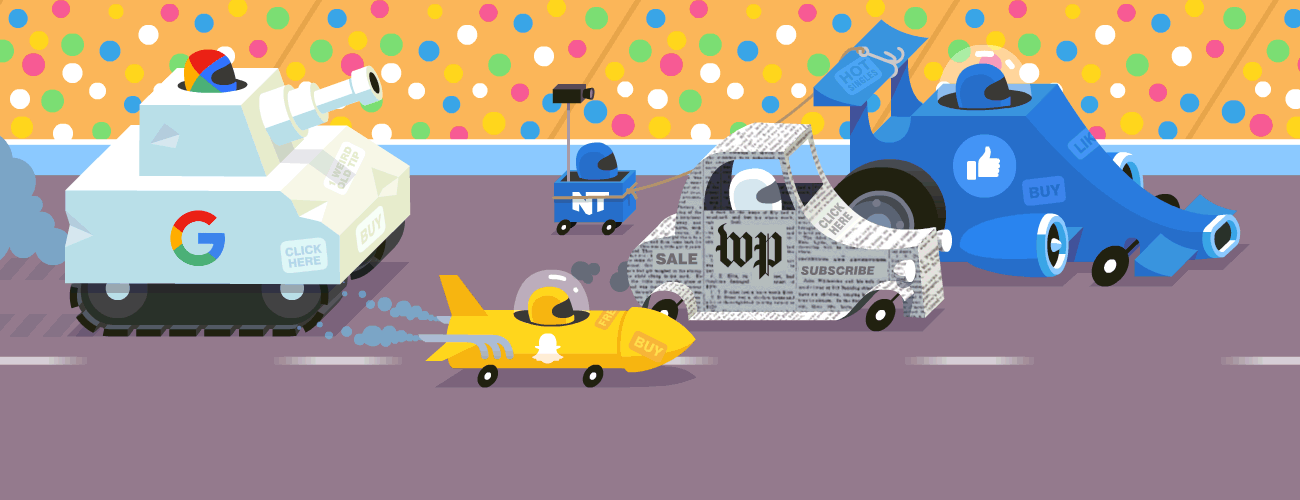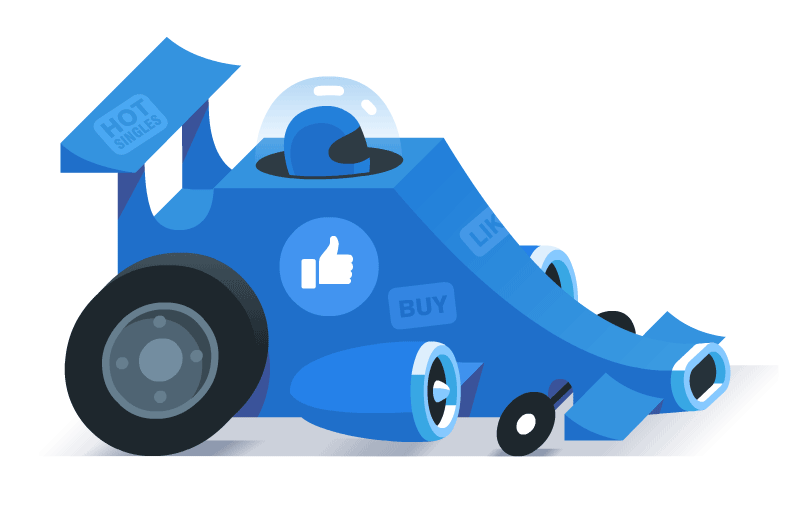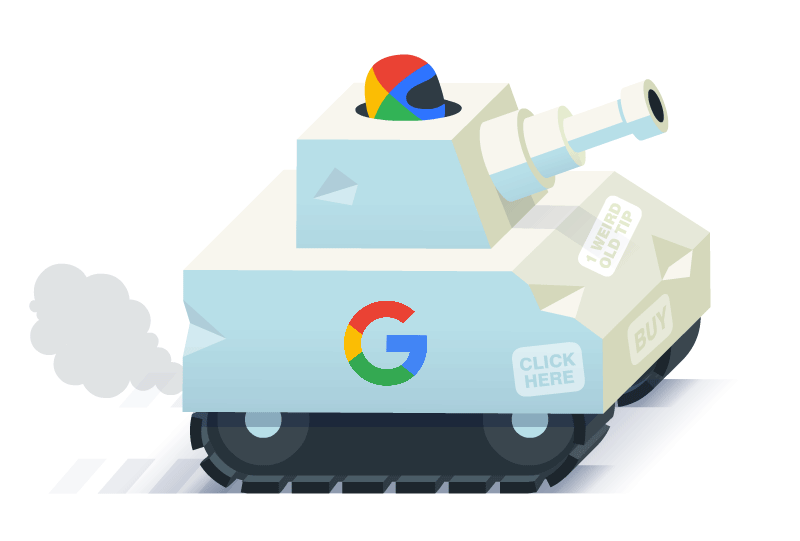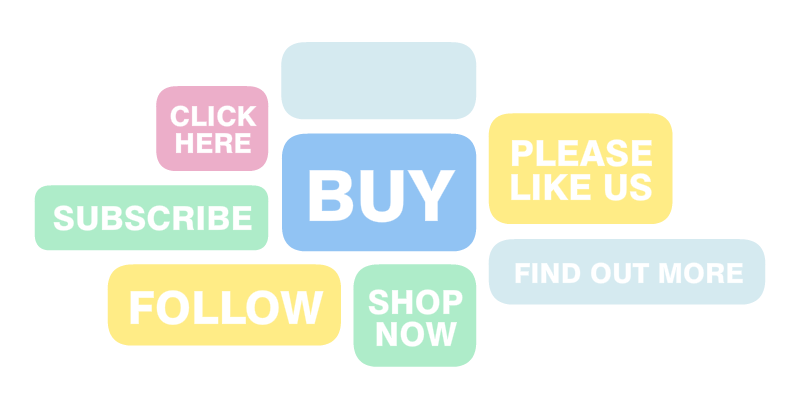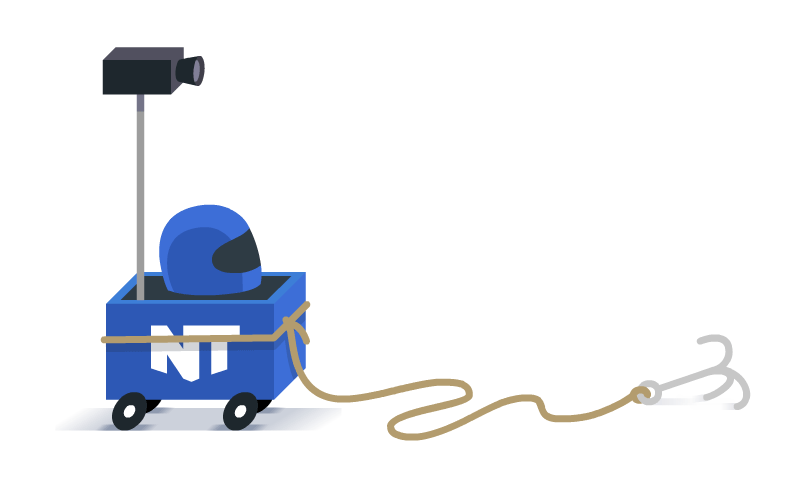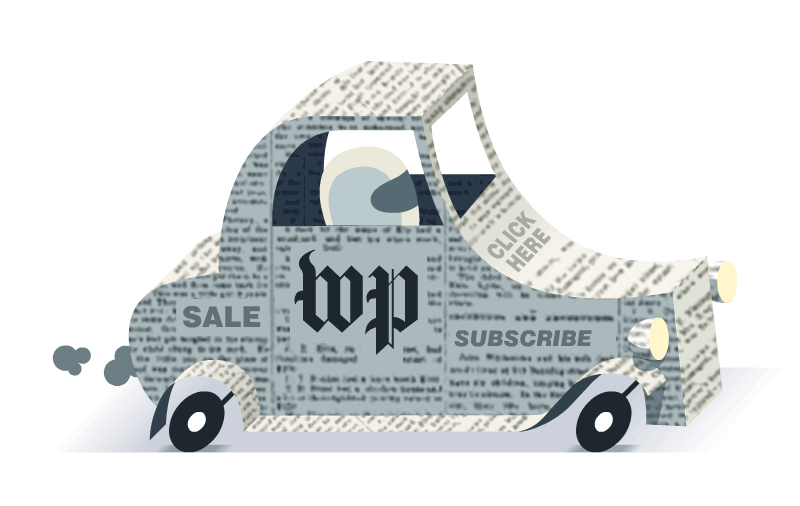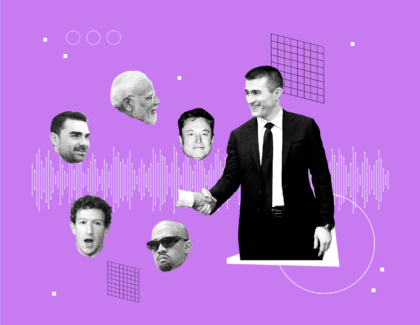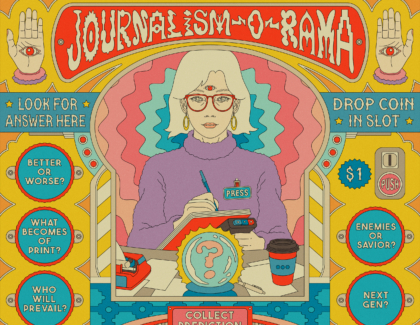Sign up for the daily CJR newsletter.
The business of publishing has been turned on its head. News outlets are handing over their journalism to powerhouses like Facebook, betting that the increased traffic will be worth the loss of control. Audiences are fickle and demanding, constantly changing what they want. Advertisers are scrambling to gain leverage. News startups are demolishing the entire publishing model, sometimes with wild success.
How to possibly make sense of it all? By thinking of it as a race, as we did, for position and power. These graphics let you sit behind the wheel with some of the industry’s top racecar drivers, from Facebook to The Washington Post, as they vie for position on the track. Hopefully, you’ll get a sharper fix on the players, the tensions, and the reordered world we all now inhabit.
If this is a race, and it is, then Facebook is in first place. By far, it is the biggest publisher in the country. About 70 percent of the country is on Facebook, with an estimated 600 million people getting news directly from the social media platform.
Among millennials, Facebook news consumption is even higher with a whopping 88 percent using the platform regularly. For many of them, Facebook is just a way to share stories and video with their friends.
Facebook’s digital ad revenue has doubled in the last two years, dominating 10 percent of all digital ad revenue and taking up more than a third of all mobile ads. This dominance is important–it shows how well the technology company has succeeded financially on mobile, which is exactly where the consumers are.
In the last few years, Facebook has been shapeshifting into a publisher and primary source of news. Its Instant Articles takes the work of newsrooms like The New York Times and publish them directly on Facebook. This allows news organizations to get more traffic and Facebook to create its own ecosystem. These Instant Articles load 10 times faster, so users not only like them but stay within Facebook’s world for all their information needs, whether it’s about friends or news. Essentially, Facebook has become the portal by which people go online.
And why wouldn’t it try to become a publisher too? After all, news is just another form of content–a commodity–that’s part of the product Facebook sells its customers. What’s more, media companies have also become hugely dependent on Facebook for their traffic. When it launched Instant Articles, the country’s biggest publishers quickly signed on: BuzzFeed, HuffPost, the Times and The Washington Post. Today, Vox gets 40 percent of visits through the site, while BuzzFeed says Instant Articles bring in more audience than any other platform.
What’s clear in this arrangement is that Facebook holds the cards. But what that means for the future is less clear. Might it tighten the controls around Instant Articles to fit whatever suits its corporate strategy? Will it favor publishers who use Facebook’s ad network. Will it hide data from news organizations? Will it make judgments around what type of content a publisher puts on its platform–if not directly, then by re-prioritizing what appears in users’ feeds. What is certain is that Facebook won’t stop experimenting with news. Only it needs both users and publishers to keep coming back.
If there is one fact that publishers should keep in mind, it is this last one. For all the headaches, news organizations still have something Facebook needs, and that’s a hand they should play carefully.
Snapchat
If Facebook leads the publishing field, Snapchat, the youngest contender running a social platform, is catching up fast. What started off as a fun, instant messaging app that allows users to send photos and videos that disappear in seconds, has evolved into a bigger publishing platform. Now, users can broadcast their own “story” to the world via a 24-hour collection of photos and videos, or access news content specifically designed for Snapchat.
Last year Snapchat launched its own platform, Discover, that allows publishers to release new and exclusive content like videos, articles, and infographics on a daily basis. The ad revenue is flowing in, too, with projections for continued revenue that helped Snapchat get a generous new round of funding.
This entry into news has come almost as a reaction to Facebook’s Instant Articles. “Social media companies tell us what to read based on what’s most recent or most popular. We see it differently,” Snapchat says in describing its philosophy, emphasizing the role of editors and artists over clicks and shares to determine what stories are important.
Snapchat is pint-sized compared with the giants of social. On any given day, it has about 100 million active Snapchat users, a sliver of Facebook’s (989 million). But Snapchat has something the giants don’t: an abundance of young viewers. Most Snapchat users are between the ages of 13 and 25. The average Facebook user is 40 years old, which means that based purely on its user base, Snapchat is the fastest growing of any social networks. This gravitation of kids to Snapchat is also why Facebook offered to buy it for $3 billion. They said no.
Snapchat’s approach with Discover is to keep the party small and stay mindful of its audience. With only a handful of publishing partners including Vice, Mashable, and The Wall Street Journal, Fortune has called Discover “the cool kids table” of media. If publishers don’t generate enough views or manage to hook new, younger audiences, Snapchat gives them the boot and brings new publications in–as it did last July when it replaced Yahoo and Warner Music Group with iHeartRadio and BuzzFeed.
When it first launched, Snapchat partnered with only 10 publishers. Now, it’s up to 23. By design, the company doesn’t have an ad sales team large enough to support demand, so it depends on its media partners to sell.
As Snapchat ventures deeper into news, it will become less of a video playground and more of a central portal for publishers wanting a pipeline to youth.
The wired world from Google’s chair isn’t looking so good right now. Sure, it’s one of the world’s largest corporations with over $50 billion in ad revenues last year, but the massive technology company gets the bulk of that money from its search engine. And that market is in upheaval.
Consider these facts. Since 2014, mobile use has increased at such a fast pace that the average person now spends more time on their phone than they do on desktop computers. What’s more, an astounding 87 percent of all time spent on mobile is spent on apps–not browsing the Web.
This is a problem for a company that gets its money by capturing information on how people search the Web and then serving them personalized ads the next time they sign on. Unfortunately for Google, that’s not possible when everyone’s using apps.
This digital chaos has dropped Google into crisis mode. As a result, it’s scrambling for answers, first by looking at why people are moving onto apps to begin with. If there is one primary reason, it’s that people are annoyed by how slow the Web can be. So consumers are responding in two ways: by moving to fast-loading apps, or by installing ad blockers to speed up and de-clutter their experience online. Both are disastrous for Google. Instant Articles will result in users having to never leave the Facebook ecosystem, causing near panic for Google, the traditional gatekeeper of the Web.
Google’s solution is something called Accelerated Mobile Pages, essentially a mission to make the mobile Web as good as apps are now, through faster-loading pages and a streamlined advertising experience.
Media publishers are happy that Google has provided them a framework to address issues of speed outside the closed ecosystem of Facebook, as AMP is an open source project with different news publishers, ad-providers and analytics firms all contributing to it.
However, some outlets are concerned that they are being strong-armed into adopting AMP, as AMP articles show up at the top of the Google search page. To make matters more complicated, AMP comes with significant technological challenges requiring the creation of a second code base with a specific type of HTML code, but many are forced to make the investment to remain relevant on Search.
One of the concerns raised by publishers is that AMP pages mark a radical departure from when Google served as a gateway to their websites. With AMP, the content is served from Google’s cache (which is simply a mirror of the publisher’s page) and the reader remains in the Google ecosystem. While it still counts as a page view for the publisher, if you email or share an AMP article, the URL is not of the publisher’s website, but instead appears as google.com/amp/publishersite.com/publisherpage/amp. Therefore, even though the page views go back to the publisher when an AMP article is read, the publisher still loses out on branding.* Google has also been experimenting with a new feature, separate from AMP, where breaking news articles under 14,400 characters are posted directly onto search and bypass the publisher’s own website entirely.
All this activity has played into concerns of media outlets that they are being blindsided by tech companies wanting to cut them out of the distribution channel. Google, however, has maintained that AMP is different from other closed ecosystems and helps the mobile internet thrive as an open network.
“On all the things that we are doing, we try to live by a core philosophy. One, that the approach is open to all to participate. Secondly, a keen respect in the publishers need to create an experience for users which allows them to engage further and build a relationship with publishers,” says Richard Gingras, senior director of news and social products at Google. “Third, respect for the publishers need to own the monetization of that experience. So all of these cut across our various efforts.”
Read the full interview with Richard Gingras about the problems and future of AMP here.
Advertisers
“Half the money I spend on advertising is wasted; the trouble is I don’t know which half.” The advertising scene has changed considerably since John Wannamaker, considered one of the forefathers of advertising, immortalized this frequently quoted cliché in the late 1900s. Advanced data collection and sharper analytics have changed that. Today, advertisers have a far greater ability to direct their ads to the customers most likely to buy them. Advertising is now a science–we know what works and what doesn’t.
Unsurprisingly, Google and Facebook, each with warehouses of invaluable data, have emerged as the biggest winners of this trend. A Morgan Stanley study found that in the first quarter of this year, more than 85 percent of the $60 billion online ad industry was routed through these two technology giants.
Google, in particular, has emerged as the piping through which modern advertising travels. Like many other industries, the ad industry is being automated to a large degree, with 25 percent–or $15 billion–of digital ads coming through programmatic ads. This is an automated system of buying and sellings advertising that matches ads with available inventory across the Web, using algorithms. Through several strategic acquisitions and takeovers, as much as 73 percent of Google’s ad buys now comes through programmatic ad buys, a market expected to have an average annual increase of 27 percent over the next four years.
All these technological shifts have been challenging for most media outlets, which aren’t typically very tech savvy. Newsrooms are now scrambling to get the technological capability to collect primary data on their readers. In the meantime, to avoid dependence on Google and Facebook, they’re forced to enter into partnerships with third party providers like Taboola that collect only general demographic information, which is not as valuable as the more personalized information that Google and Facebook provide.
The saving grace, however, is that advertisers, like media publishers, are wary of putting all their eggs in only a few baskets.
“There is still a lot of merit in advertising with people that are not Facebook and Google, such as getting a specific audience in a specific mindset,” said Ryan Engels, a director at Media Link, a consulting company with clients in the media and advertising world. “Google and Facebook are essentially monopolies, it would only be worse if people actually came out and said they are the only place we want to go….If you put everything there, Google and Facebook have you.”
NowThis
If there is one news organization that has wholesale gambled its future on someone else’s social platform, it’s the upstart video news production company called NowThis. Go to its website and something will immediately hit you: There is no homepage, only a bar of icons linking to Tumblr, Kik, YouTube, Facebook, Twitter, Instagram, Vine, and Snapchat.
Oh, and a reminder to “like” and “follow” NowThis across those channels. That’s the strategy. “The news is where you live,” a message to readers says. That motto has been up since NowThis, a liberal, all-video news platform, nixed its homepage in early 2015. After Facebook began including the number of views on videos in the fall of 2014, NowThis saw its audience grow exponentially—to 60 million views per month. For many news sites that have struggled to draw an audience to their videos, that’s a shocking number.
These high numbers prompted NowThis to exclusively release content across digital social media platforms. Updated features—such as autoplay—and a clear commitment to video from Facebook worked to the organization’s advantage. As social platforms become increasingly motivated to work with publishers—especially with video content that keeps people engaged and staying longer—Facebook has also developed tools to help publishers analyze the performance of their products and better understand audience engagement.
Without a legacy to maintain and a consistent format—always video, always topical, always the same tone—NowThis is exploding, hitting 1.5 billion views on Facebook in March 2016. While the ultimate authority over publishing rests with the platforms—and that can be intimidating—single-focus media companies like NowThis stand to benefit from partnering across social channels.
Audience
In the chaotic media industry, it is the consumers of news who occupy the driver’s seat. Their ever-shifting behavior has all the other players chasing after them. Once, they liked getting information from newspapers, then it was their desktops, then Kindles, no, forget Kindles, now phones, and Facebook. First they consumed text. Now its video. To understand their behavior, think about three factors: speed, loyalty, and mobility. Let’s take them in that order.
Speed: Consumers want their news fast and layered. No lag time and no obstacles. This thirst is quenched best by Facebook, Google, Apple, and tech giants who are devising fast-load pages like no other competitors. Not long ago, consumers would click an article on Facebook and it would load in a new browser within about eight seconds. Apparently, 70 percent of readers are less likely to abandon articles when content appears immediately. Sorry, legacy publications, this comes at a cost. Pull your hair out all you want. The speed of a loading bar, or in some cases, the spinning wheel, has begun to replace the publisher.
Loyalty: News sites better get used to a brutal fact: Most of their readers aren’t that loyal. They don’t typically read stories by visiting homepages, and they’ll only come back if enticed to do so. Once again, this puts them in the driver’s seat. Chase, chase, chase is about all the publishers can do to keep in their audience’s good graces. Traffic from referrals or social media have been steadily climbing the past two years. Facebook surpassed Google in 2015, doubling its rate to 43 percent within the span of half a year. In 2010, social media referral rates were at 10 percent. Who cares about brand, or the judgment of reporters and editors, so long as the algorithm is functioning to satisfaction? In other words, why log into a host site when it’s available by way of a platform like Facebook?
Mobility: Today, some 90 percent of users get their news off phones. After all, phones are everywhere—the number of people who have a phone shot up wildly since 2011, when just 46 percent of the population used phones compared to 82 percent now. Clearly, the appeal of mobile is about, well, mobility. It’s convenient. It may also be about the physical touch, the handheld size, and the quiet intimacy that a phone brings. All that pulls people toward phones and away from their desktops. Desktop use has sunk to 35 percent in the past two years. This is not to say it’s over for the dense and dusty desktop. To state the obvious, it’s long past time for publishers to start thinking mobile first and to stop hoping it’s a trend. The actual phones we use will keep changing, but their existence won’t. And consumer appetite for better and better mobile content will only keep growing.
The Washington Post
Choices are tougher for a legacy brand like the Post. For established news organizations, the question of turning over content to platforms like Facebook becomes more intricate. It’s one thing to shutter the homepage when you’re a relative fledging like NowThis. It’s quite another if you’ve controlled your own journalism for over a century and want to retain control over its publication. So instead, places like the Post and The New York Times are searching for a middle ground. Though The Washington Post is still investing in its own platforms and apps, it is increasingly utilizing others’ platforms, especially Facebook’s. The site is a supermarket of content—leisure reading, straight information, brewing news, video, and more—with an enormous scale of distribution and a dependable number of eyes. As newer media companies like Vox, BuzzFeed, and The Huffington Post harness the potential of social media to their benefit, legacy organizations like the Post and the Times are scrambling to catch up. In the fall of 2014, the Post announced it would join Facebook Instant Articles, upping its previous engagement on a platform where its readers were already spending the majority of their screen time.
But Facebook is both friend and foe. Instant Articles present a new set of challenges: The slimmed down, streamlined articles pose questions about how the platform will host graphics-heavy content or specialized, signature journalism with more cumbersome digital components, such as data and interactives. Does Facebook care about press freedom the way news organizations have historically? Meanwhile, questions about algorithms abound, as do proper communications with partners. Once you lose control of publishing decisions, a lot can go out the window.
The stakes are high. But ultimately, legacy media organizations know that it is Facebook, Google, and even emerging social channels that have the best understanding of technology. And whether they like it or not, technology is the engine driving the media industry these days.
*An earlier version of this story incorrectly stated that AMP content is hosted by Google. While the version that readers access is Google’s cached copy, the hosting for all AMP articles is done by publishers.
Has America ever needed a media defender more than now? Help us by joining CJR today.



